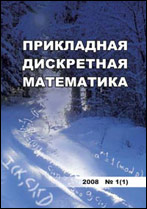|
This article is cited in 5 scientific papers (total in 5 papers)
Mathematical Methods of Cryptography
Cryptanalytic concept of finite automaton invertibility with finite delay
G. P. Agibalov
National Research Tomsk State University, Tomsk, Russia
Abstract:
The automaton invertibility with a finite delay plays a very important role in the analysis and synthesis of finite automata cryptographic systems. The automaton cryptanalitic invertibility with a finite delay $\tau$ is studied in the paper. From the cryptanalyst's point of view, this notion means the theoretical possibility for recovering, under some conditions, a prefix $\alpha$ of a length $n$ in an unknown input sequence $\alpha\delta$ of an automaton from its output sequence $\gamma$ of the length $n+\tau$ and perhaps an additional information such as parameters $\tau$ and $n$, initial ($q$), intermediate ($\theta$) or final ($t$) state of the automaton or the suffix $\delta$ of the length $\tau$ in the input sequence. The conditions imposed on the recovering algorithm require for prefix $\alpha$ to be arbitrary and may require for the initial state $q$ and suffix $\delta$ to be arbitrary or existent, that is, the variable $\alpha$ is always bound by the universal quantifier and each of variables $q$ and $\delta$ may be bound by any of quantifiers — universal ($\forall$) or existential ($\exists$) one. The variety of information, which can be known to a cryptanalyst, provides many different types of the automaton invertibility and, respectively, many different classes of invertible automata.
Thus, in the paper, an invertibility with a finite delay $\tau$ of a finite automaton $A$ is the ability of this automaton to resist recovering or, on the contrary, to allow precise determining any input word $\alpha$ of a length $n$ for the output word $\gamma$ being the result of transforming by the automaton $A$ in its initial state $q$ the input word $\alpha\delta$ with the $\delta$ of length $\tau$ and with the known $n, \tau, A, \gamma$ and $\upsilon\subseteq \{\delta, q, \theta, t\}$ where $q$ and $\delta$ may be arbitrary or some elements in their sets and $\theta $ and $t$ are respectively intermediate and final states of $A$ into which $A$ comes from $q$ under acting of input words $\alpha$ and $\alpha\delta$ respectively. According to this, the automaton $A$ is called invertible with a delay $\tau$ if there exists a function $f(\gamma, \upsilon)$ and a triplet of quantifiers $\varkappa\in\{Q_1x_1Q_2x_2Q_3x_3: Q_ix_i \in\{\forall q, \exists q, \forall\alpha, \forall\delta, \exists\delta\}, i \neq j \Rightarrow x_i \neq x_j\}$ such that $\varkappa[f(\gamma, \upsilon)= \alpha]$; in this case $f$ is called a recovering function, $(\varkappa, \upsilon)$ — an invertibility type, $\varkappa$ — an invertibility degree, $\upsilon$ — an invertibility order of the automaton $A$ and $\exists f \varkappa[f(\gamma, \upsilon)= \alpha]$ — an invertibility condition of type $(\varkappa, \upsilon)$ for the automaton $A$. So, 208 different types of the automaton $A$ invertibility are defined at all. The well known types of (strong) invertibility and weak invertibility described for finite automata earlier by scientists (D. A. Huffman, A. Gill, Sh. Even, A. A. Kurmit, Z. D. Dai, D. F. Ye, K. Y. Lam, R. Tao and many others) in our theory belong to types $(\forall q\forall\alpha\forall\delta, \emptyset)$ and $(\forall q\forall\alpha\forall\delta, \{q\})$ respectively.
For every invertibility type, we have defined a class of automata with this type of invertibility and described the inclusion relation on the set of all these classes. It has turned out that the graph of this relation is the union of twenty nine lattices with thirteen of them each containing sixteen classes and sixteen lattices each containing thirteen classes. To solve the scientific problems (invertability tests, synthesis of inverse automata and so on) related to the different and concrete invertibility classes, we hope to continue these investigations.
Keywords:
finite automata, information-lossless automata, automata invertibility, cryptanalytic invertibility.
Citation:
G. P. Agibalov, “Cryptanalytic concept of finite automaton invertibility with finite delay”, Prikl. Diskr. Mat., 2019, no. 44, 34–42
Linking options:
https://www.mathnet.ru/eng/pdm659 https://www.mathnet.ru/eng/pdm/y2019/i2/p34
|

|




 Contact us:
Contact us: Terms of Use
Terms of Use
 Registration to the website
Registration to the website Logotypes
Logotypes








 Citation in format
Citation in format 
